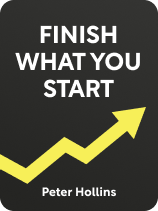

This article is an excerpt from the Shortform book guide to "Finish What You Start" by Peter Hollins. Shortform has the world's best summaries and analyses of books you should be reading.
Like this article? Sign up for a free trial here.
How can you turn your ambitious projects into completed achievements? What’s holding you back from following through on your goals?
Finish What You Start, a book by Peter Hollins, explores the mindsets and habits that empower people to accomplish their life goals. Hollins provides insights on developing a finisher’s mindset, preparing for productive action, and maximizing your work efficiency.
Keep reading to discover Hollins’s techniques for sustaining motivation and seeing your projects through to completion.
Finish What You Start Book Overview
Do you constantly start ambitious projects only to run out of steam halfway through? You’re not alone. Although it’s easy to be enthusiastic about your goals while setting them, many people find that this motivation fades quickly. But it doesn’t have to. Finish What You Start, a book by Peter Hollins, explains how to develop mindsets and habits that will empower you to follow through on your life goals.
Hollins is an author and researcher specializing in psychology. He has written over 50 books on the topics of self-discipline and accelerated learning, including The Science of Self-Discipline and Mental Models.
We’ll begin this overview by dissecting the mindset—or mental habits—that you need to sustain motivation toward your goals. Then, we’ll detail simple actions you can take to prepare for highly motivated work. Finally, we’ll discuss what you can do while working to maximize your productivity.
How to Develop a Finisher’s Mindset
According to Hollins, if you want to commit to finishing your life goals, you need to develop the right mindset. He defines “mindset” as the mental habits you use to make sense of your life experiences. Your mindset determines your attitude toward the problems in your life. Thus, without the right mindset, you’ll never work up the motivation to solve your problems and achieve your goals.
We’ll provide several of Hollins’s tips for developing the most productive mindset.
Tip #1: Identify Your Sources of Intrinsic Motivation
First, Hollins suggests precisely identifying what motivates you. There are two kinds of motivation: extrinsic and intrinsic. Extrinsic motivation is rooted in external rewards and punishments. For instance, if you want to earn a large holiday bonus or avoid disappointing your co-workers, you’re being driven by extrinsic motivation.
In contrast, sources of intrinsic motivation only exist inside you. If you believe that something you’re doing is morally right, worthwhile, or enjoyable, that would be intrinsic motivation.
Although Hollins asserts that both forms of motivation are useful, he argues that intrinsic motivators are typically more powerful than extrinsic motivators in the long run. To this end, identifying your existing sources of intrinsic motivation allows you to consciously focus your attention on them. This focus strengthens your dedication and helps you make progress more easily.
To identify your intrinsic motivators, Hollins recommends asking self-reflective questions. Ask yourself what positive emotions you expect to feel after you attain success, how your life will be different, and how your accomplishments will help the people you care about. All of the things you’re eager to gain by achieving your goals are your intrinsic motivators. For instance, if you want to start a community food bank, your intrinsic motivators might be the idea of improving the lives of people in need and the feelings of pride that come with this.
Tip #2: Avoid Rumination
Hollins recommends that you develop the habit of acting before you think you’re ready instead of ruminating. Ruminating is when you spend too much time weighing the possible future consequences of your decisions. As a result, you’ll probably fail to make substantial progress toward your goals.
According to Hollins, one likely reason you ruminate (and procrastinate in other ways) is because you’re afraid of failing to achieve your goals and being judged negatively by others. To avoid failure and rejection, you obsess over doing everything you can to ensure a perfect outcome. However, since it’s impossible to ensure a perfect outcome, this mindset causes you to endlessly plan and overanalyze, never feeling fully prepared to take action.
Worrying about the future diverts your attention from the present moment, which makes it more difficult for you to take action and make decisions that lead you toward your goals. Hollins recommends doing everything you can to focus on acting responsibly in the present moment. What you do right now determines whether you’ll succeed—ruminating isn’t likely to help you much.
To avoid rumination when making decisions, Hollins suggests identifying and focusing exclusively on the most significant determining factors. Then, deliberately ignore everything else. This way, you can minimize the time you spend thinking while still making well-informed decisions. For example, if you’re trying to decide whether to accept a job offer, identify the factors that had the greatest impact on your satisfaction in your last job (perhaps flexible scheduling and autonomy at work). Then, judge the new job solely on those criteria.
Tip #3: Set Reasonable Expectations
Hollins warns against overestimating how easy it’ll be to achieve your goals. If you have overly optimistic expectations, you’ll only be disappointed when you don’t achieve your goals straight away. This disappointment can be very demotivating, making you less likely to persevere in the future.
Similarly, Hollins cautions against overestimating how happy achieving your goals will make you. If you expect that working hard and getting something you want will completely transform your life, you may be disappointed and demotivated if that’s not the case.
To avoid feeling disappointed and demotivated, manage your expectations: Set realistic progress goals so you can reliably complete them and feel satisfied. Likewise, don’t assume that accomplishing a single goal will resolve all the problems in your life that are making you unhappy.
Tip #4: See Failures as Learning Opportunities
Finally, Hollins recommends viewing your life journey as a never-ending process of incremental growth. As you complete tasks and achieve your goals, you can assess what parts of your strategy and mindset work well (and which don’t), and you can identify areas for improvement. Note that the optimal conditions and strategies for success are different for everybody. The goal is to discover the conditions and strategies that best suit your unique strengths.
According to Hollins, every time you fail, it’s a sign to reexamine your working conditions, strategies, and mindset to discover why you failed. The cause may be anything from a suboptimal work schedule to negative emotions that pressure you into giving up. By repeatedly identifying and resolving the problems that cause you to fail, your chances of success will continually improve.
Additionally, when you use failures as valuable learning opportunities, you’ll come to see them as a good thing. Then, you won’t be as afraid of failing, making it easier to motivate yourself to take action.
How to Prepare for Productive Action
Once you’ve started developing a productive mindset, you’ll be somewhat motivated to put in the work required to achieve your life goals. But Hollins argues that there’s no need to rely solely on your mindset for motivation: If you prepare properly before you start working, you can plant the seeds for future motivation and make your tasks much easier to overcome.
Here are five actions you can take to prepare for progress toward your life goals.
Action #1: Set Up Sources of Extrinsic Motivation
Hollins advises setting up ongoing sources of extrinsic motivation. Although internal motivators are generally more effective in the long run, supplementing them with short-term extrinsic motivators can boost your productivity.
One effective source of extrinsic motivation is social pressure. Ask someone in your life to regularly do motivational check-ins with you. They should know when you need to take productive action, get in touch to make sure you do, and express their disappointment if you fail to act. The threat of letting this person down will motivate you to get things done.
According to Hollins, another way you can leverage extrinsic motivators is by setting up a situation in which you lose or waste a significant amount of money if you fail to take productive action. For example, purchase a year’s subscription to a sophisticated diet-tracking app. You’ll be motivated to track the food you eat so the money you spent on the app doesn’t feel wasted.
Hollins asserts that you may find it useful to combine these two strategies: Give a friend a sum of money, then tell them not to return it until you complete your goal. This way, you’re motivated by the fear of losing money and looking bad in front of someone you care about.
Action #2: Create a Reminder of What’s Motivating You
Hollins recommends creating a persistent reminder of your extrinsic and intrinsic motivators so they’re always at the front of your mind. This reminder can be anything you associate with your motivators. For instance, you could keep a rock from your vacation to Iceland on your desk to remind you of your intrinsic motivation to be more adventurous in your day-to-day life. Alternatively, if you’re leveraging extrinsic motivation by asking a friend to make sure you’ve written a new song every week, you could change your computer’s desktop background to a picture of their face.
As these examples illustrate, you should put the reminder somewhere you’ll engage with it frequently. Ideally, whenever you encounter your reminder, it’ll snap you out of unproductive mental habits like rumination and motivate you to take action. Make this reminder as prominent as possible so you don’t overlook it.
In addition to creating a reminder of what’s motivating you, Hollins recommends making a scoreboard, a visual depiction of your progress on your goals. This is essentially a large to-do list posted somewhere you can see it frequently: Write down tasks you need to accomplish and cross them off as you complete them.
Like your other, more general reminder, seeing this scoreboard will motivate you to act. The goal is to make completing tasks feel like you’re winning a game. Promise yourself a treat as a “prize” for accomplishing a major task down the road. Celebrating the steps you take toward this prize will motivate you to continue.
Action #3: Create Strict Rules for Yourself
Hollins suggests writing a set of rules to help you follow through on your goals. Once you get in the habit of following certain rules, they allow you to make decisions automatically instead of relying solely on willpower to drive healthy behavior.
He explains that these useful rules come in two types: restrictions that cap the amount of unproductive actions you’re allowed to take and obligations that outline actions you must take. To ensure your restrictions and obligations are as effective as possible, make them precise and concrete. Design them to apply every day, so you’re constantly making progress toward your goals. For example, you could set the restriction that you can’t watch more than two episodes of a TV show per day, or set the obligation that you must eat a portion of fruits and vegetables with every meal.
Action #4: Atomize Your Tasks
According to Hollins, the hardest part of any task is starting—if you consider the enormous amount of work ahead all at once, it can overwhelm you with anticipation of discomfort and fear. Thus, another useful action you can take to prepare for work is to break your next task down into extremely small, easy-sounding steps. For example, if you need to plan your entire wedding, just focus on one step at a time: Decide on a budget. Write a list of supplies and services you need. Spend twenty minutes researching potential catering options.
Making your first step as easy as possible reduces your fear and resistance to the task, allowing you to make progress. As you successfully take little steps, your goal will seem increasingly attainable as you prove to yourself that you’re capable of moving forward. This allows you to accelerate your progress over time.
Action #5: Schedule Time for Self-Care
Finally, Hollins recommends setting aside time to rest and take care of yourself. Establish a regimented schedule with plenty of time for work, but also schedule a significant amount of time during which you must relax.
According to Hollins, if you never allow yourself time to rest, you’re likely to build up chronic stress. This stress can wreak havoc on your productivity: You’ll find it more difficult to build the willpower necessary to take productive action, and the fears that discourage you from acting can overpower you much more easily.
Hollins notes that even if you’re not chronically stressed, your brain requires periods of unfocused rest to function optimally. Unfocused attention and mindless activities like daydreaming trigger alpha waves, a type of neural activity that promotes creativity and feelings of happiness. Such benefits make it much easier to progress toward your goals. Therefore, try not to use social media during your time away from work. This focused stimulation doesn’t allow your brain to shift into a healthy, scattered state.
How to Properly Work Toward Your Goals
Now that we’ve discussed how to develop a motivated mindset and prepare for your best work, let’s examine some of Hollins’s tips for being as productive as possible while working.
Tip #1: Work on One Task at a Time
Although multitasking can make it feel like you’re being unusually productive, Hollins asserts that it’s ineffective. Whenever you switch between tasks, you continue having thoughts about the previous task for some time. These thoughts distract you from the task at hand, resulting in decreased productivity and performance. Instead, you’ll get much more done if you focus solely on one task for an extended stretch of time.
With this in mind, Hollins recommends grouping tasks that require the same kind of thinking and completing them in a single session. This way, you’re essentially combining them into one task, allowing you to avoid the splintered attention that comes from repeatedly switching between tasks. For example, block out two hours every month to handle all your financial management tasks at once—pay your credit card and electricity bills, create a budget for next month, and review your investment portfolio.
Tip #2: Combine Treats With Tasks
According to Hollins, another way that you can maximize your productivity is by treating yourself at the same time you complete unpleasant but necessary tasks. For example, order delivery from your favorite local restaurant and eat it while researching how to set up a retirement fund.
Hollins explains that normally, your desire for short-term pleasure is at war with your desire for long-term improvements to your life: You must sacrifice one for the other. Unfortunately, short-term pleasure often wins, causing you to continually treat yourself and put off productive action. However, if you can find a way to make productive action pleasurable in the moment, you’ll resolve this conflict. Consequently, you’ll be motivated to finish tasks that you might have otherwise avoided indefinitely.
Tip #3: Resist Compulsions by Considering the Future
According to Hollins, an effective way to resist compulsions and distractions is by considering your life in its totality rather than just the immediate present.
If you’re being productive and you notice that you’re about to stop and surrender to a compulsion, stop and think about how you’ll feel about your decision in the future. You’ll gain a more accurate idea of how little this compulsion will please you in the long run, motivating you to resist it.
When you think about the future, consider imagining the worst-case scenarios that could occur if you gave into your compulsions or put off work. Hollins contends that fear of these negative futures may motivate you to make wiser decisions. For example, if you’re tempted to watch TV instead of spending time playing with your child, imagine how heartbroken you’d feel if they grew up emotionally distant and rarely talked to you as an adult. Use this strategy in moderation—obsessing over worst-case scenarios too often can cause excessive stress and anxiety, which can ruin your productivity.
Hollins argues that examining the big picture of your life can also help you stay committed to your life goals when you’re more seriously considering giving up. Strengthen your determination by asking yourself three questions: Ultimately, what do you want most? What do you need to do to get it? What actions should you avoid to get what you want? Your answers will clarify what you truly want to do in life.

———End of Preview———
Like what you just read? Read the rest of the world's best book summary and analysis of Peter Hollins's "Finish What You Start" at Shortform.
Here's what you'll find in our full Finish What You Start summary:
- How to finish that ambitious project you’re putting off
- The type of mindset that will keep you motivated
- How your environment is distracting you from important things






